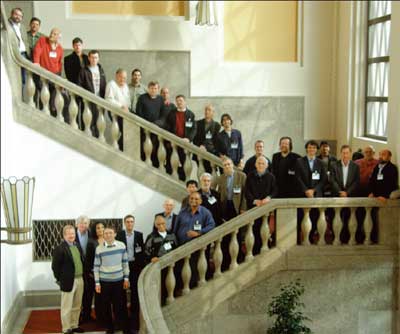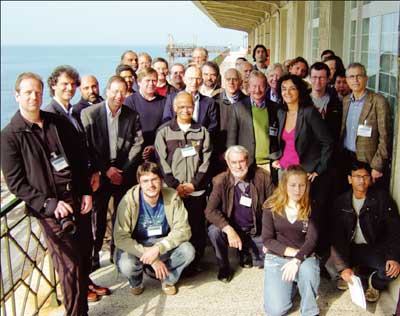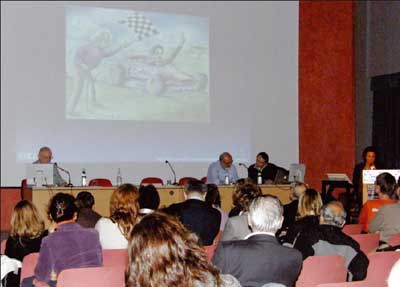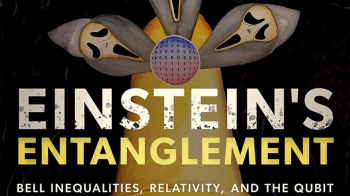The SpinStat 2008 workshop looked at the nature of space–time.
The Pauli exclusion principle (PEP), and more generally the spin-statistics connection, plays a pivotal role in our understanding of countless physical and chemical phenomena, ranging from the periodic table of the elements to the dynamics of white dwarfs and neutron stars. It has defied all attempts to produce a simple and intuitive proof, despite being spectacularly confirmed by the number and accuracy of its predictions, because its foundation lies deep in the structure of quantum theory. Wolfgang Pauli remarked in his Nobel Prize lecture (13 December 1946): “Already in my original paper I stressed the circumstance that I was unable to give a logical reason for the exclusion principle or to deduce it from more general assumptions. I had the feeling, and I still have it today, that this is a deficiency. The impression that the shadow of some incompleteness fell here on the bright light of success of the new quantum mechanics seems, to me, unavoidable.” Pauli’s conclusion remains basically true today.

Image credit: Erica Novacco.
The PEP was a major theme of the workshop “Theoretical and experimental aspects of the spin-statistics connection and related symmetries” at SpinStat 2008, held in Trieste on 21–25 October at the Stazione Marittima conference centre. Some 60 theoretical and experimental physicists attended, as well as a number of philosophers of science. The aim was to survey recent work that challenges traditional views and to put forward possible new experimental tests, including new theoretical frameworks.
A single framework for discussion
On the theoretical side, several researchers are currently exploring theories that may allow a tiny violation of PEP, such as quon theory, the existence of hidden dimensions, geometric quantization and a new spin-statistics connection in the framework of quantum gravity. Others have done several experiments over the past few years to search for possible small violations of the spin-statistics connection, for both fermions and photons. Thus scientists have recently obtained new limits for the validity of PEP for nuclei, nucleons and electrons, as well as for the validity of Bose–Einstein statistics for photons. These results were presented during the workshop and discussed for the first time in a single framework together with theoretical implications and future perspectives. The aim was to accomplish a “constructive interference” between theorists and experimentalists that could lead towards possible new ideas for nuclear and particle-physics tests of the PEP’s validity, including the interpretation of existing results.

Image credit: Catalina Curceanu.
The workshop benefited from the presence of researchers who have devoted a life’s work to the thorough examination of the structure of the spin-statistics connection in the context of quantum mechanics and field theory. In addition, young scientists put forward suggestions and experimental results that may pave the way to interesting future developments.
Oscar W Greenberg of the University of Maryland opened the workshop with a review talk on theoretical developments, with special emphasis on quon theory – which characterizes particles by a parameter q, where q spans the range from –1 to +1 and thus interpolates between fermion and boson – in an effort to develop more general statistics. Greenberg is the originator of this concept and he continues to be a major contributor to its theoretical development, maintaining a high degree of interest in the field. Robert Hilborn of the University of Texas reviewed the past experimental attempts to find a violation. Other theoretical speakers included distinguished scientists such as Stephen Adler, Michael Berry, Aiyalam P Balachandran, Sergio Doplicher, Giancarlo Ghirardi, Nikolaos Mavromatos and Allan Solomon.

Image credit: Erica Novacco.
The experimental reports included presentations on spectroscopic tests of Bose–Einstein statistics of photons by Dmitry Budker’s group at the University of California and the Lawrence Berkeley National Laboratory, and studies of spin-statistics effects in nuclear decays by Paul Kienle’s group at the Stefan Mayer Institute for Subatomic Physics in Vienna. Other talks included results from the Borexino neutrino experiment and the DAMA/LIBRA dark-matter detector in the Gran Sasso laboratory, the KLOE experiment at Frascati, the NEMO-2 detector in the Fréjus underground laboratory and the dedicated Violation of the Pauli exclusion principle experiment in the Gran Sasso laboratory. Each talk was followed by lively discussions concerning the interpretation of the results. Michela Massimi of University College London closed the workshop with an excellent talk on historical and philosophical issues.
Another highlight was the event held for the general public: a reading of selected parts of the book by George Gamow and Russell Stannard, The New World of Mr Tompkins, where the professor depicted in Gamow’s book was played by a witty Michael Berry from the University of Bristol. This event was a success, especially among the young students who participated so enthusiastically.
Overall, the workshop showed that the field is full of new and interesting ideas. Although nobody expects gross violations of the spin-statistics connection, there could be subtle effects that may point to new physics in a context quite different from that of the LHC.
The workshop was sponsored jointly by the INFN and the University of Trieste. It received generous contributions from the Consorzio per la Fisica, the Hadron Physics initiative (Sixth Framework Programme of the EU) and Regione Friuli–Venezia Giulia.








